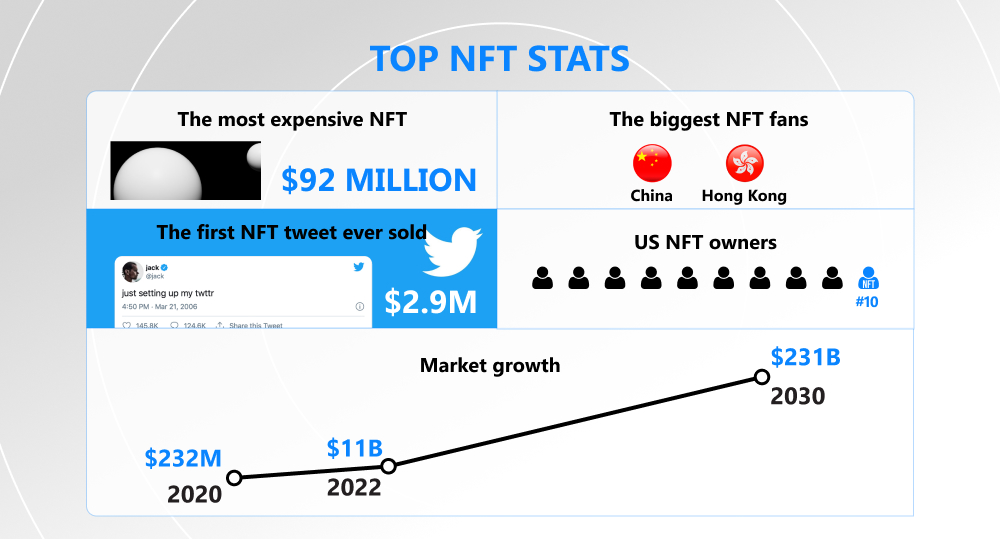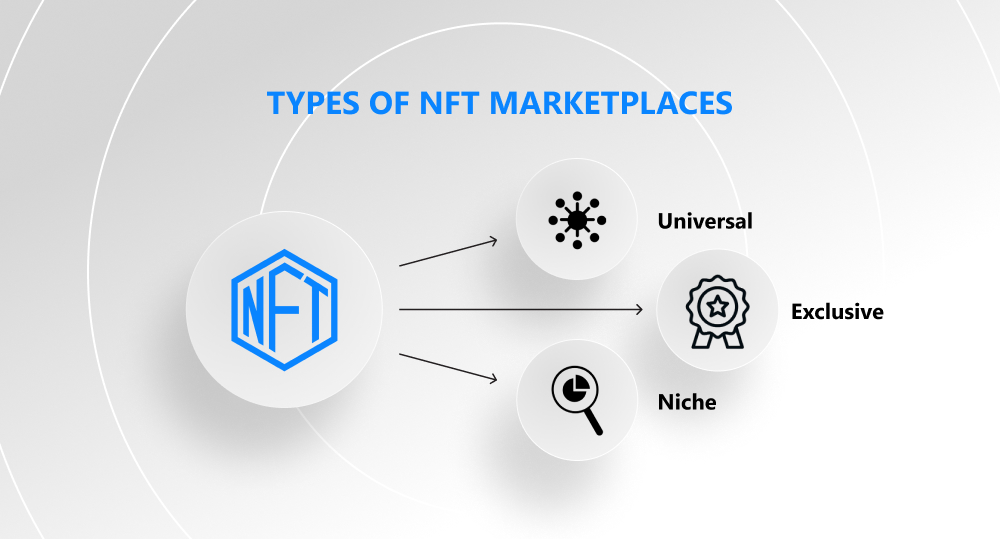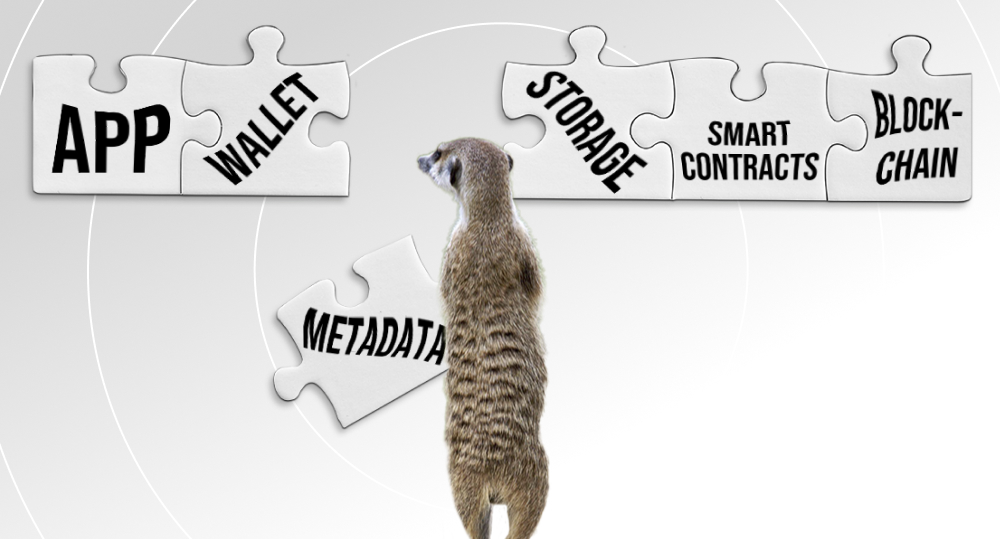Over the last couple of years, news headlines have been peppered with statements like “another NFT sold for $XX million” or “the bidding for a new work by a famous NFT designer ended at a whopping $YYY million!” The whole NFT and decentralized marketplace thing sounds like a magnet to invest into creating a blockchain platform for trading digital assets. But how to develop an NFT marketplace as popular as OpenSea and as unique as Cryptokitties?
If that question haunts your mind, you've followed the right link. We'll explain what an NFT marketplace is, how it works, and how you can launch your own product in 2023. Let's get started!
written by:
Matvey Zholudev
Software Developer
Contents
NFT: Random Fad or Integral to the Future Digital World?
When it comes to the world of digital assets, blockchain technology, and online marketplaces, one buzzword pops up more and more often: NFT.
NFTs, or non-fungible tokens, are digital assets that are unique and cannot be interchanged. In contrast to cryptocurrencies, which are fungible crypto tokens that can be traded as equivalents.
Non-fungible tokens are used for everything from art and collectibles to gaming items and website domains. Since they're stored on a blockchain, they're secure and transparent.
What role do NFTs play in the digital world, and are they worth the investment? Some people consider non-fungible tokens a passing fad, while others are convinced they are here to stay and will play a major role in the future digital economy.
Let's take a closer look at some curious NFT statistics:
After examining the key facts about the latest craze in the burgeoning blockchain industry, it's clear that NFTs may be more than just a passing trend. Here are a few more reasons why:
- They enable us to own digital assets in a verifiable and secure way.
- They offer creators a new and innovative method of monetizing their work.
- Non-fungible tokens have the potential to change how we interact with digital content. For example, we can use them to create unique experiences or reward people for their contribution to the online community.
If that's enough for you to venture into NFT market development, let's move on to the components you'll need to do so.
A Recipe for a Thriving NFT Marketplace
Despite making a big splash in the world of online art and digital collectibles, decentralized marketplaces are still a Wild West of sorts. There are no clear rules or guidelines, and any enthusiast can launch an NFT platform without much planning or forethought. As a result, many projects fail to take off or fizzle out quickly.
How do you create a successful online marketplace that can survive and stay ahead of the competition? Below is our recipe for success.
Major Types of NFT Marketplaces
The first essential step in developing an NFT marketplace is to determine the type of platform you want to create. Here's a quick rundown of the most common ones:
Universal NFT Marketplaces
This type is the most popular, as it allows users to buy, sell, or trade any sort of NFT: from artwork to in-game items to website domains. Universal platforms enable collectors to find the digital assets they like without being tied to a certain category, style, or genre.
Target audience:
- Diverse, from newcomers to seasoned collectors.
Examples:
Exclusive NFT Marketplaces
Exclusive platforms tend to have a curated selection of NFTs. Most often these are rare art collections where digital items exist in a single copy or in limited quantities and are of high value to collectors.
Target audience:
- Collectors of rare NFTs.
Examples:
Specific Niche NFT Marketplaces
Niche marketplaces focus on specific industry segments. For example, there may be a trading platform for art NFTs, in-game items, sports collectibles, or a blockchain data marketplace. The main reason for their popularity is the ease of finding a certain type of NFT.
Target audience:
- Anyone with specific requirements for non-fungible tokens.
Examples:
Platform
Number of NFTs
NFT Types
Digital Currency
Supported Blockchains
OpenSea
80M+
Art, music, photography, sports, virtual world, domains, trading cards, utility NFTs, etc.
ETH, SOL, AVAX, USDC, BNB, DAI
Ethereum, Polygon, Solana, Klaytn, Arbitrum, Optimism, Avalanche, BNB
Magic Eden
8K+ collections
Gaming, art, music, collectibles
SOL, ETH
Ethereum, Solana
Mintable
1.3M
Art, music, domains, collectibles
ETH
Ethereum
SuperRare
38K+
Art
ETH
Ethereum
Foundation
100K+
Art
ETH
Ethereum
Nifty Gateway
10K+
Art, music, photography
ETH
Ethereum
NBA Top Shot
40K+
Sports
ETH, Bitcoin, Bitcoin Cash, USD Coin
Flow
Axie Infinity
11M+
Gaming
ETH
Ethereum
Coachella
300+
Music
SOL
Solana
How Do NFT Marketplaces Work?
In terms of interaction between users, many decentralized online marketplaces function similarly to traditional marketplaces like Amazon or eBay. In both cases, sellers list items for purchase and other users browse those offers and buy the goods they want.
However, there are some substantial differences between an ordinary e-commerce marketplace and its blockchain counterpart. What are they?
Decentralized Blockchain Technology
NFT platforms use blockchain technology to trade tokens, as it allows for secure and transparent marketplace transactions. When a person buys or sells a non-fungible token, the transaction is recorded on the blockchain. This public record can be verified by anyone, making fraudulent NFT trading impossible.
The top 7 leaders in blockchain for marketplace development include:
- Ethereum;
- Polygon;
- Solana;
- BNB Chain;
- Cardano;
- Flow;
- TRON.
Smart Contracts
Blockchain marketplaces rely on smart contracts to facilitate transactions. A smart contract is a digital agreement written on a blockchain network that enables the transfer of tokens between parties. When the buyer and seller agree to the terms of the deal, they can use the smart contract to execute the transaction.
These computer protocols automate the transaction process and help ensure that both parties fulfill their part of the deal. They also serve to protect buyers and sellers from fraud by verifying the authenticity of traded NFTs.
Workflow
Every platform (no matter whether it’s an Ethereum, Solana, or Flow blockchain NFT marketplace) follows a similar workflow. After signing up for the service and connecting a crypto wallet, users can go two ways, depending on their role as a creator or collector:
1) To mint, upload, and sell NFTs. For putting a token up for sale, the seller needs to determine the payment currency and set the price (fixed or auction-based).
2) To collect NFTs. All it takes is selecting a token you like and buying it. If the seller has put the item up for auction, the collector will have to bid higher than other users.
Key Elements of an NFT Marketplace
If you want to build a popular and profitable NFT marketplace, you can't do without a few basic ingredients. Here they are:
Application
It is the marketplace itself, where users can easily browse through all the NFTs available for sale, make offers, and complete NFT transactions. Your app should be able to provide secure escrow payments to protect every user from scammers.
NFT Wallet
This is where users can store their NFTs after purchase. A digital wallet is also necessary for selling tokens, as it's usually used to transfer ownership of NFTs from one person to another.
NFT Metadata
These are data describing the NFT, such as the title, creation date and time, image, and other relevant information. They are valuable for two reasons: first, they help potential buyers understand what they're buying, and second, they allow marketplaces to properly categorize and curate their collections.
Data Storage System
You will also need a secure and decentralized storage to keep token metadata. Some popular methods include:
- IPFS (InterPlanetary File System);
- SQL databases;
- JSON files.
Smart Contracts
These are the backbone of any platform, used to track ownership, verify authenticity, and enforce transaction terms. Popular standards include:
- ERC-721;
- ERC-1155;
- BEP-721;
- BEP-1155.
Blockchain Integration
Blockchain is the technology that powers NFTs. Without it, your marketplace cannot function, and NFTs will simply be digital files with no inherent value. The three most popular blockchain networks are Ethereum, Solana, and Polygon. There are significant differences between them, so choose wisely.
Ethereum Blockchain
Solana Blockchain
Polygon Blockchain
Native Token
ETH
SOL
MATIC
Founded
2015
2017
2017
Transaction Speed
20/sec
50,000/sec
65,000/sec
Consensus Mechanism
Proof of Stake
Proof of Stake, Proof of History
Modified Proof of Stake
Transaction Fees
$15
$0.00025
$0.03
Scalability
Limited
High-performance protocol for scalability
Thanks to multichain architecture, it’s highly scalable
Marketplace Examples
Rarible, CryptoKitties, Foundation
Solanart, Solsea, Metaplex
NFTrade, Treasureland, Refinable
How to Develop an NFT Marketplace: A 4-Stage Tutorial
The NFT marketplace development process is not quick or easy, but it's definitely doable with proper planning, execution, and a skilled team of blockchain developers. This tutorial will walk you through four basic stages of developing a cutting-edge online marketplace based on blockchain technology.
Stage 1. Analysis & Planning
Primary goal:
- Determine the architecture and functional requirements of the product in mind.
The first stage of development is devoted to high-level analysis and planning. It is also called pre-study. In this phase, it's crucial to analyze the project, its goals, the target audience, and to plan the necessary technical architecture. The process should result in an accurate timeline of the product development from start to finish.
Main steps:
- Define the target audience, use cases, and user journeys;
- Determine the key functionality;
- Create a UI/UX design concept;
- Define the technical structure;
- Conduct a gap analysis of the marketplace API;
- Decide on the required tech stack;
- Create a high-level architectural plan.
Stage 2. Prototyping
Primary goal:
- Test the feasibility of the proposed solution with its prototype.
The next stage in our NFT marketplace development tutorial is dedicated to creating a prototype of your future product. It is also called the Proof-of-Concept stage. It enables testing the product concept before investing too much time and resources into development.
The prototyping stage is crucial as it allows you to create a working model of your blockchain-based marketplace, which can be used to test various aspects of the platform. This includes UI/UX, the type of NFTs to support, and the back-end infrastructure. By developing a prototype, you will be confident that your solution is well-designed, user-friendly, and can handle the volume of transactions you expect.
Main steps:
- Develop and implement 1–2 key features;
- Deploy smart contracts;
- Conduct performance testing;
- Analyze the results;
- Gather feedback from early users;
- Make necessary changes to the prototype;
- Continue testing until the product is proven feasible.
Stage 3. Building a Minimum Viable Product
Primary goal:
- Release an MVP with a minimal number of features to gather feedback and iterate on the product.
Once you have completed the prototype testing and collected all the necessary user feedback, you should move on to the MVP phase. The MVP should not be confused with the prototype. While it is not yet the final version of the marketplace, it already has sufficient functionality and design to attract users.
Building an MVP is all about striking the right balance between scope and functionality. You want to make sure the MVP has all the key features that your blockchain-based marketplace needs, but don't go overboard and include features that aren't necessary.
Main steps:
- Develop and release an MVP;
- Implement the UI/UX design;
- Test the MVP and collect user feedback;
- Make improvements before releasing the full version.
Stage 4. The First Release
Primary goal:
- Release a full-scale product to the public.
The first release is especially crucial, as it sets the stage for all future releases. This is the milestone that determines whether customers will adopt your product or not. Here are a few tips to get it right:
- Make sure your platform is stable and ready for public use. Beta testing can be a helpful way to catch any last-minute bugs or glitches.
- Create a marketing plan to generate buzz around your launch. This can include social media campaigns, press outreach, and influencer partnerships.
- Have a clear understanding of your business model and how you plan to generate revenue. This will be critical to investors and users alike.
Further steps:
- Monitor the progress of your product;
- Collect user feedback;
- Address any issues that arise;
- Prepare for the second release with more features and expanded functionality.
At first glance, this manual looks too complicated to implement for a newcomer to the industry. Therefore, our advice is to outsource a competent development team with extensive experience in building a blockchain-based marketplace.
FAQ: All the Things You Were Afraid to Ask about Developing an NFT Marketplace
1. How Much Does It Cost to Develop an NFT Marketplace?
A rough cost of NFT marketplace development can range from $50,000 to $350,000. This amount will increase if you decide to add unique functionality, support multiple blockchain platforms, or invest in additional services such as marketing or customer support.
2. How Long Does It Take to Create a Blockchain-Based Marketplace?
It takes approximately 25–35 weeks to develop a fully functioning platform. This time frame may be shorter or longer, depending on the specific requirements of the project. Here are some estimates from our experience:
- Pre-study: 2–4 weeks;
- POC: 4 weeks;
- MVP: 10–12 weeks;
- R1: 10–12 weeks.
3. Is It Possible to Develop a Multiсhain NFT Marketplace?
Yes. You don't have to develop a platform that works with only one type of blockchain. Using different types of blockchain in the marketplace offers many advantages: your product will be more powerful and versatile, transaction costs will be lower, and you will expand your reach by entering new markets. One of the most prominent examples of such products is OpenSea.
4. Which Is Better: SDK or Custom NFT Marketplace Development Platform?
If you're looking for a quick and easy way to get your blockchain ecommerce marketplace up and running, the SDK option may work for you. It’s perfect for simple services such as a universal platform or a marketplace for freelancers. Several decent SDKs can easily be found on GitHub. However, custom solutions offer more flexibility and control. If you have certain requirements for a future product, for example, you want to build a specific niche solution, experiment with the design, or add a few unique features, custom development will be a better alternative.
5. What Are the Main Challenges of Today's Blockchain Marketplace?
Since the industry is quite young, there are still a few kinks that need to be worked out:
- Cybersecurity threats;
- Low liquidity;
- Smart contract risks;
- Legal regulation in different countries;
- Limited payment methods;
- Unsatisfactory user experience;
- High and hidden gas and transaction fees;
- Lack of standardization
Ready to Hit It Off with Blockchain Technology?
There's no doubt that NFTs are the future of digital art and commerce. In just a few short years, we're sure to witness the rise of large NFT marketplaces and the creation of NFTs worth billions of dollars. If you're going to create a platform to trade non-fungible tokens, there's no better time than now. With a little planning and expert help from the right people, you can launch your own marketplace in 2023. What are you waiting for? Dare to get a taste of NFT deals.
Want to get started with your own NFT marketplace, but don’t know where to begin? Qulix has the expertise it takes to get you at the forefront of this exciting new industry. Contact us today to learn more about our professional NFT development services.

Contacts
Feel free to get in touch with us! Use this contact form for an ASAP response.
Call us at +44 151 528 8015
E-mail us at request@qulix.com












